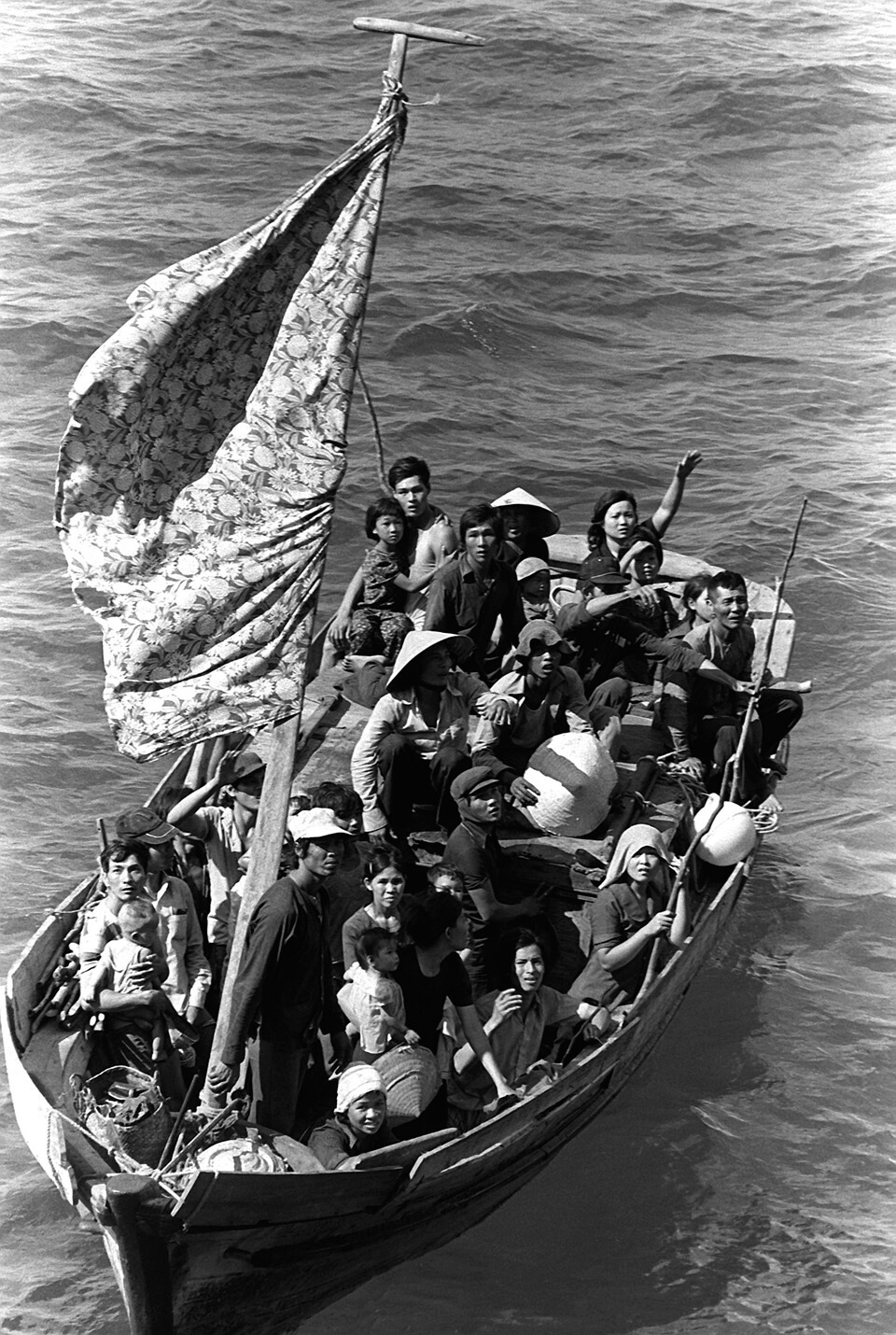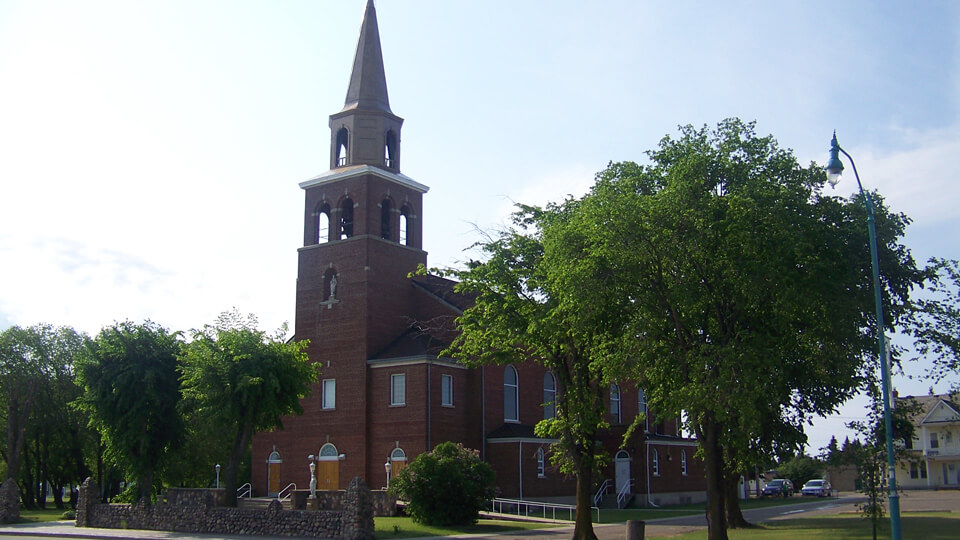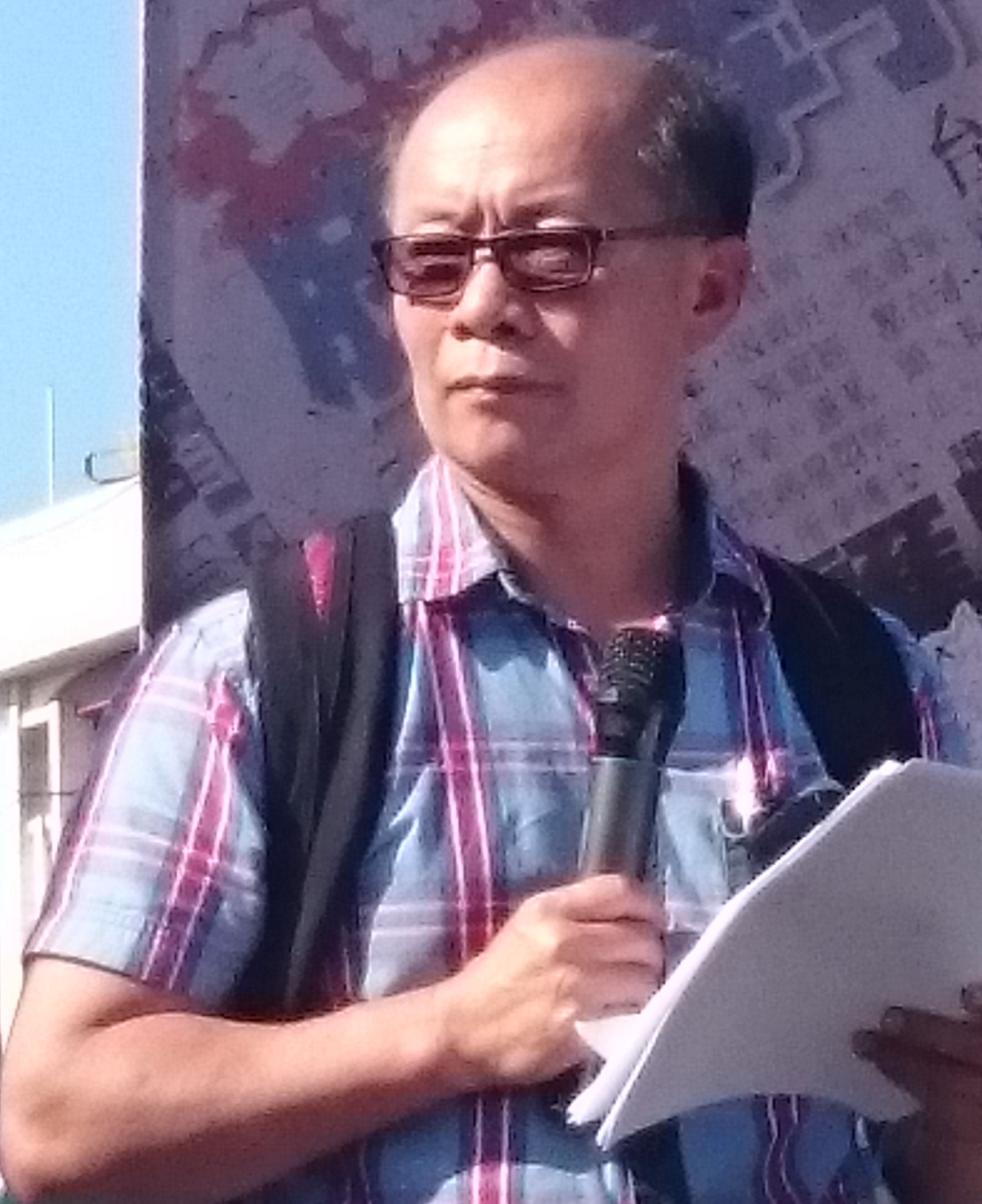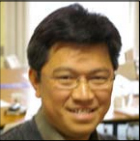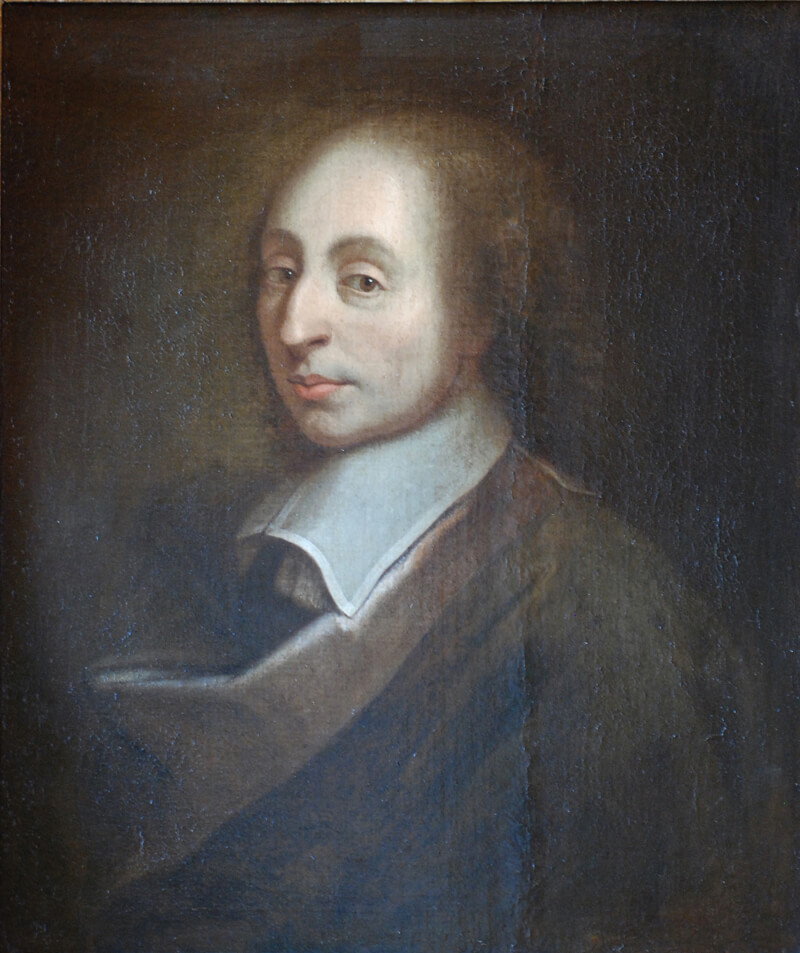Misyon Online - March-April 2017
A Seminarian For Thirty Years
By Fr Dominic Derramas
The author, a priest of the Diocese of Bacolod, is studying for his Doctorate in Canon Law at the Angelicum University, Rome. He is staying at the Pontificio Collegio Filippino where Fr Peter Tuyen The Tran also resided while studying at the Lateran University in Rome. That’s how the young Bacoleño priest, who wrote about the faith of his late father, Antonio Sr, in the May-June 2016 issue of MISYONonline.com, came to know the remarkable and inspiring story of the Vietnamese priest.

Fr Peter Tran, Chancellor of the Diocese of St Paul in Alberta, Canada, 2004-2015
St John Paul II, on the fiftieth anniversary of his priestly ordination, said that every priestly vocation at its deepest level, ‘is a great mystery; it is a gift which infinitely transcends the individual.’ (John Paul II, Gift and Mystery: On the Fiftieth Anniversary of my Priestly Ordination.) This is true for the vocation story of Fr Peter Tran who became a seminarian at the age of eleven but was ordained at the age of 41. His priesthood is, in the words of St John Paul II, both a gift and a mystery.
Tuyen The Tran was born in Đồng Tháp, Vietnam, to a devout Catholic family on 2 December 1951, the second of five children, and grew up in a religious atmosphere where his vocation to the priesthood was nourished from a very early age. The family belonged to an active parish community that lived peacefully alongside their Buddhist neighbors. He was baptized with the Christian name ‘Peter’ and studied in the Catholic elementary school beside the parish church. As a child, he was an altar server and attended Mass every day. The parish priest noticed this and chose him to enter the seminary. Thus, his high school education was completed in Saint Qui Minor Seminary in Cái Răng, Cần Thơ.
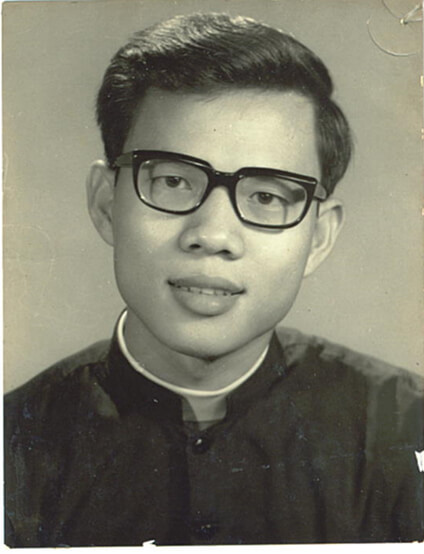
Graduate in theology, 1979
Peter Tran gradually clarified his vocation to the priesthood and proceeded to Saint Sulpice Seminary in Vĩnh Long for his Philosophy studies, which he completed in 1975, the year that the whole country came under the Communist Regime. All seminarians were sent home as the government took control of all educational institutions, including seminaries.
Peter stayed and served in his parish until the government eased its restrictions and allowed the seminarians to gather five months each year for their theological studies. The Catholic Church wasn’t totally banned but endured a form of oppressive scrutiny and severe limitations from the government. There were no Catholic schools and no formal teaching of religion. The government only allowed Catholics an hour or two each day to go to Church every day and a maximum of five hours on Sunday.
More pressure from the government only strengthened the faith of the people. They found creative ways to grow spiritually despite the limitations on their freedom. There was no formal catechesis but they were able to maximize the hours they spent in church every Sunday for learning about their faith and building a stronger Christian community.
Peter finished his Theological studies in 1979 but faced another restriction. Those to be ordained needed to submit their names to the government for approval. He applied for permission from the government and while waiting for the response stayed at the bishop’s residence and worked as his secretary.
Approval for ordination took more than two years after application because the government performed a thorough background check on the applicants. Peter applied four times but was rejected for various reasons. The first time, he was told that there were enough priests already so no more ordinations for a few years. He applied again after a few years but this time the political and military backgrounds of his brothers were sufficient to deny him ordination.
There were eighteen seminarians in Peter’s batch and eleven had already been ordained. Peter persevered and remained as a seminarian beside his bishop. He patiently performed his duties as secretary and doing his apostolate among the people, most especially in catechesis and the music ministry. After ten years of rejection, he had to face the reality that he would never be given permission by the Communist government to be ordained.
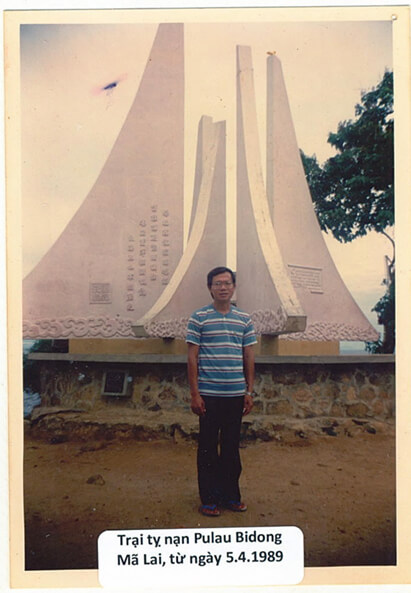
In refugee camp in Pulau Bidong, Malaysia, 1989 - 1991
Peter now had to face the difficult decision of staying in Vietnam as a lay person or finding some means of being ordained outside the country. It was a choice between the people he wanted to serve and the call to the priesthood. After careful discernment, he decided to follow God’s mysterious call even if it meant leaving the land where he thought he was needed.
And so, without any clear idea of where he would end up or what would happen to him, Peter took the risk of escaping Vietnam by joining the ‘boat people’ who braved the dangers of the sea in flimsy boats to seek refuge in other countries. After four perilous days on at sea the boat he was on arrived at the island of Pulau Bidong off the coast of Malaysia.
Vietnamese boat people awaiting rescue [Wikipedia]
This small island was the designated refugee camp for those fleeing Vietnam during those times. When Peter arrived there in 1989 there were about 10,000 refugees packed within its one square-kilometer area. Conditions were difficult despite the assistance of the United Nations Commission for Refugees (UNHCR) and other humanitarian agencies. He stayed in the refugee camp for two years, studying English while waiting for resettlement. He spent his time also working for Canadian officials of UNHCR. It was through this connection that he was able to leave the camp.
St Paul Cathedral, St Paul, Alberta, Canada [Wikipedia]
Peter arrived in Canada in 1991 through a friend who sponsored him and found himself in St Paul, Alberta. Not knowing anybody connected to the Catholic Church in Canada, he attended daily Mass in the cathedral just to get his bearings. After a few days, he was invited by his friend to attend Mass in the chapel of a nearby Sisters’ convent. Arriving early, he was strolling around the garden of the convent he approached a man there, hoping to practice his English. He discovered he was chatting with Bishop Raymond Roy of the Diocese of St Paul in Alberta.
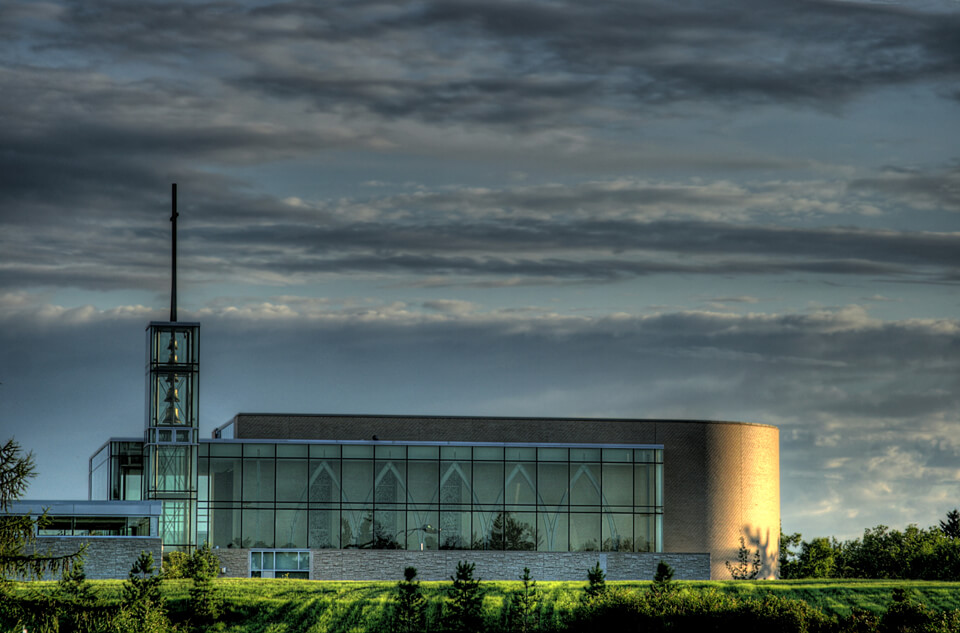
St Joseph Seminary, Edmonton, Alberta [Wikipedia]
Bishop Roy, who retired in 1997 and died in 2003, listened to Peter’s story and, after due investigation, accepted him into his diocese. That year, he was enrolled in St Joseph Seminary in Edmonton for a refresher course in theology. After eighteen months, on 22 January 1993, the refugee seminarian from Vietnam was finally ordained and became Fr Peter Tuyen Tran of the Diocese of St Paul in Alberta, Canada.
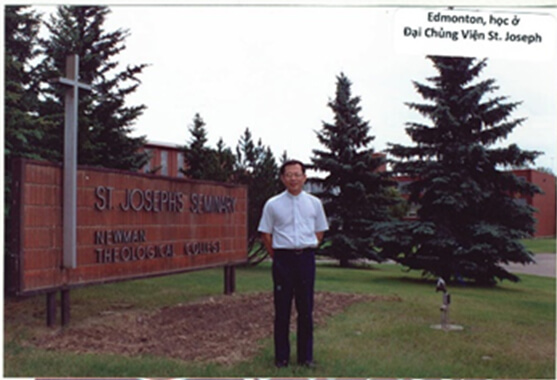
At St Joseph Seminary, Edmonton, Alberta, 1991
Fr Peter served his new diocese for 24 years. He spent thirteen years in parish work and eleven as chancellor of the diocese. He obtained a Licentiate in Canon Law from St Paul University, Ottawa, which was invaluable in his chancery work. At one time he served as Diocesan Administrator for almost a year while the diocese was waiting for a new bishop to be appointed.
All throughout those years, Fr Peter never forgot the Church in Vietnam. He feels that his vocation to the priesthood is needed more in his home country that he still loves so much. At the age of 65 he retired from active ministry, not to rest, but to go back to Vietnam. He wants to spend the rest of his priestly life and ministry in his home country. Specifically, he plans to teach Canon Law and so he spent money out of his own personal savings to finish his doctoral studies.
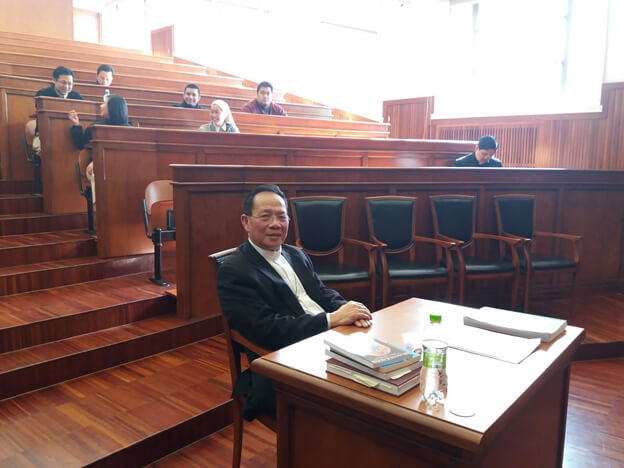
Doctor in Canon Law, Magna Cum Laude
The mystery and the gift of vocation led Fr Peter to the other side of the world. It was in following God’s inexplicable was that he realized his calling to the priesthood. It is also by God’s generous grace that in February 2017 Fr Peter obtained a Doctorate in Canon Law, Magna Cum Laude, at the Lateran University in Rome. Now, with a heart full of hope, He is preparing to return to the land he left long ago, so that finally, he can serve the people of Vietnam as a priest.
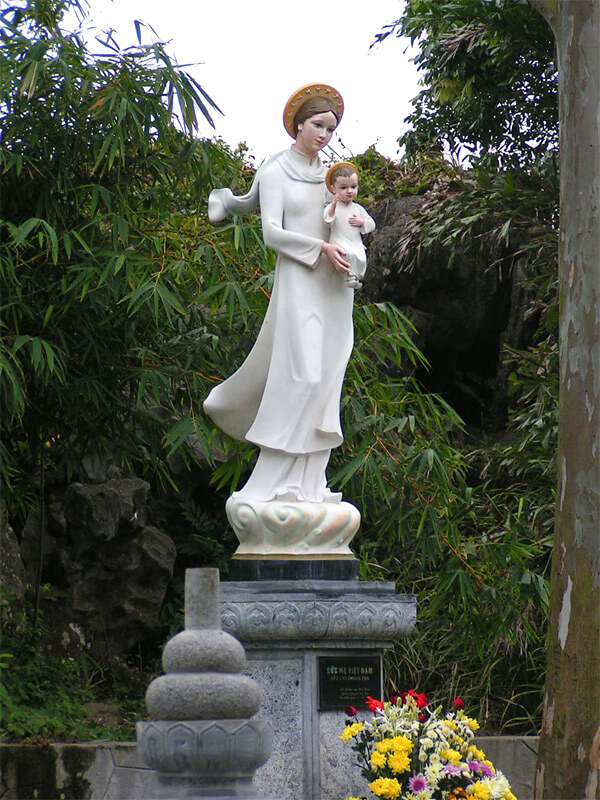
Our Lady of La Vang, Vietnam [Wikipedia]
Vietnamese Catholics in Greenville, South Carolina, USA celebrate Our Lady of La Vang
Notice the similarity to the Flores de Mayo in the Philippines.
Two Vietnamese Columban ‘Boat People’ PriestsFr Peter Nguyen Van Hung, ordained in 1991 and working in Taiwan, and Fr Nguyen Xuan Tien, ordained in 1995 and working in Japan, arrived in Australia as ‘boat people’, refugees from Vietnam. Both studied and were ordained in Australia.
Father Peter has been honoured by the US Department of State for his anti-trafficking work in Taiwan. You can read about his work in Taiwan’s desperate migrant mothers. We published an interview with Father Peter in the March-April 2001 issue of Misyon: Story of a Boat Person.
You can read the story of Fr Nguyen Xuan Tien in Farewell Saigon in the March-June 1995 issue of Misyon. |
Dialogue of Life in Lanao del Norte
Elbert Balbastro and Jerry Lohera are two Columban seminarians, Elbert from Oton, Iloilo, Panay, and Jerry from La Victoria, Kauswagan, Magsaysay, Misamis Oriental. Later this year they will be going to Pakistan for their two-year First Mission Assignment. Both entered the Columban seminary formation in June 2012. Both are now in their second year of Theology in Pastoral Ministry at Loyola School of Theology, Ateneo de Manila University, Quezon City.
In June 2016 they spent two weeks with the Maruhom Family, who are Muslims, in Sigayan, Sultan Naga Dimaporo, Lanao del Norte. Here they share their experience.
Dialogue of Life – Experiencing What Enhances One’s Understanding
By Elbert Balbastro
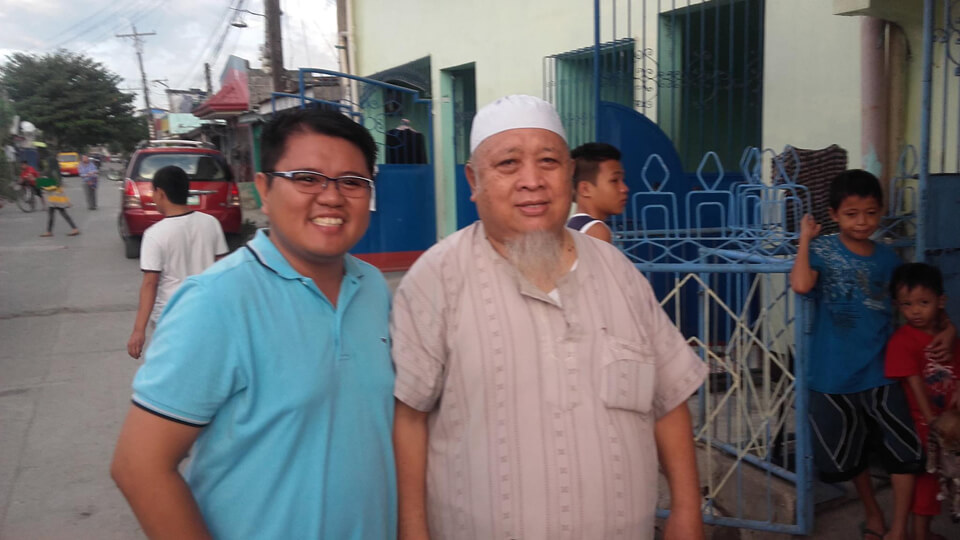
Elbert Balbastro with the Imam in the Mosque in Vamenta Subdivision, Barra, Opol, Misamis Oriental
‘Unity in the midst of diversity’ is a commonly used expression in regard to engagement in dialogue. Living for two weeks in Sigayan, Sultan Naga Dimaporo, formerly Karomatan, Lanao del Norte, in Mindanao, Philippines, with my fellow Columban seminarian Jerry Lohera, I encountered two distinct ethno-religious groups living in the same house. The first was the Meranao tribe, to which our host family, that of Ali Maruhom, belonged and the other was the Talaandigto which the woman of the house, Daya Maruhom, and her cousins who happened to be spending their vacation in the house when we arrived belonged. The Talaandig people live mostly in the Province of Bukidnon.
We usually had our meals together and shared stories such us our life experiences, the people we had met and our journeys in life. One time during supper we talked about our different cultures, religions and languages. There are many languages in the Philippines, belonging to different regions and to different tribes. For instance, my language is Hiligaynon (Ilonggo), Jerry speaks Bisaya (Cebuano). The Meranao speak their own Meranao language and the Talaandig have their own distinct language also. Our common language was Bisaya. However, despite our different languages, one thing that stood out in all our conversations is that we all believe in one God who created the Earth and we all agreed that we have the responsibility to preserve and take care of it. Though there are differences in how we name and how we profess and worship the God we know, we all believe that it is due and proper to give thanks to this Mighty One. We discussed the different names of God according to our own language – Allah, Ginoo, Magbabaya, Dios – but we agreed that this God alone is the Creator of the universe. Through these discussions we developed a good friendship and we have good memories that we will treasure.
Looking back on all of this I realize that in dealing with religions or beliefs other than my own, it is better to talk about the commonalities rather than the differences. We all recognize that there are many differences in our traditions, beliefs and understanding of things. What is important for us is to recognize the oneness and commonalities among us – Ilonggo, Bisaya, MeranaoandTalaandig– foremost among these which is that we believe in a God who created the world. Furthermore, it is also good to look at and learn from each other’s cultures and traditions because we are all Filipinos.
Coming from the island of Panay where the majority are Christians, it was quite difficult at the beginning to cope with living in Sultan Naga Dimaporo, where the majority of the people are Meranao Muslims. Amidst my apprehensions and fears – which come from exaggerated media coverage about Mindanao and the Muslims – I learned that not all we hear is correct. We need to discover the truth by living and experiencing the Muslim way of life.
I am blessed to have had this immersion experience. It has refined my understanding and has helped me to process my negative emotions and perspectives towards Muslims. Through it I have come to know about the culture and beliefs, not only of the Meranao Muslims but also of the Talaandig tribe. It was the first time that I had heard about this tribe.
Experience is indeed the best teacher. It has not only taught me to deal with my fellow beings but has also enhanced my understanding of and attitudes towards other people regardless of race, religion, beliefs, skin-color or nationality. Dialogue of Life is about letting ourselves be immersed in cultures other than our own rather than just listening to the media and reading books, newspapers and social networking sites that, inevitably, give us a very incomplete picture of the world around us.

Allahu Akbar!
By Jerry Lohera
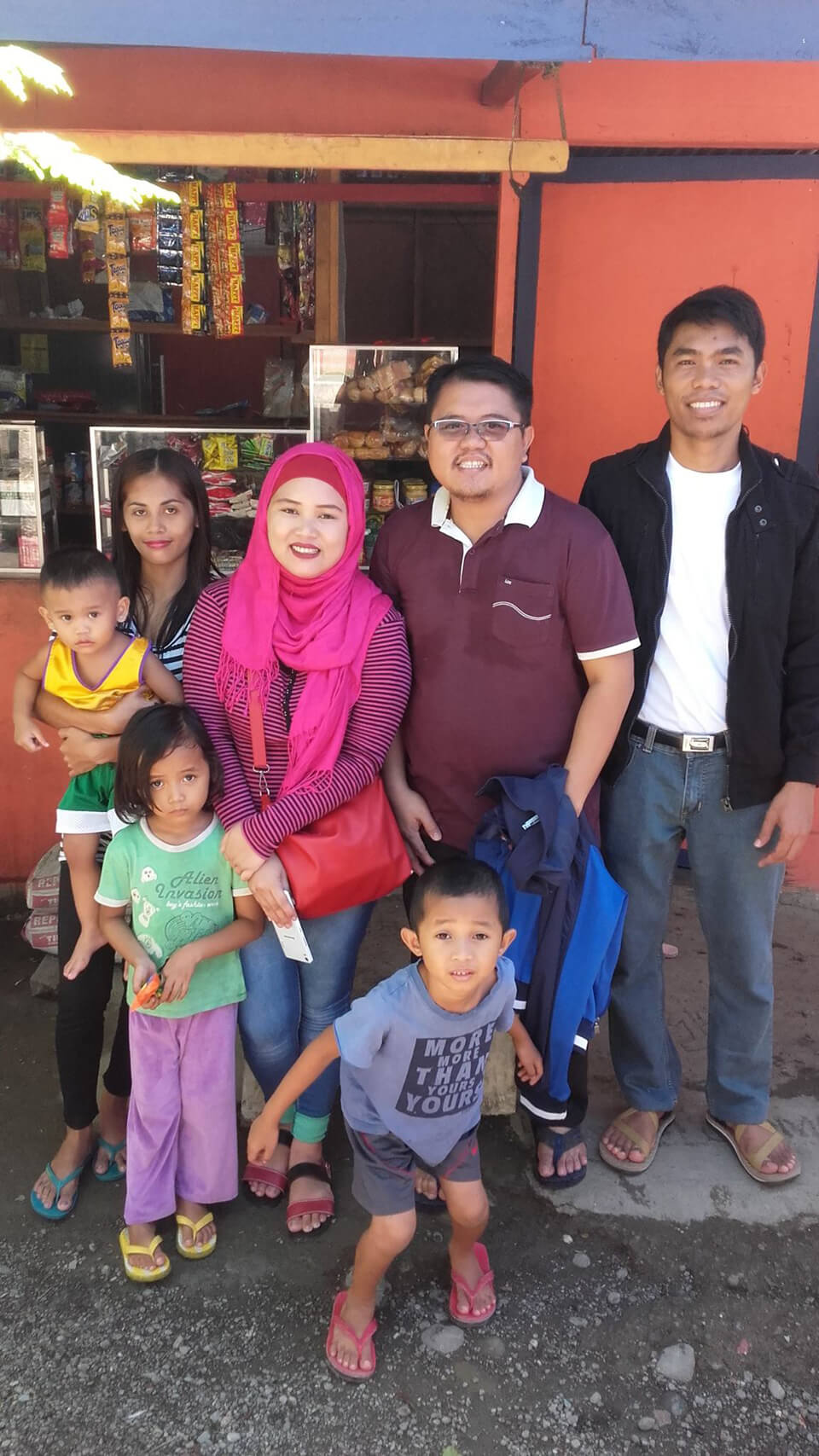
Elbert Balbastro (2nd from right) and Jerry Lohera (far right) with members of the Maruhom family.
Being with the Maruhom family in Sigayan, Sultan Naga Dimaporo, Lanao del Sur, was a memorable experience because of the observance of Ramadhan. To interiorize our solidarity as Christians with Muslims in the holy season of Ramadhan, Elbert Balbastro and I joined them in their fasting. We woke up around 3:00am to prepare our early meal. We were allowed to eat and drink water until 4:15 am and when the call to prayer was heard from the masjid, Allahu Akbar the fasting began for the day. We then returned to bed or waited for the sunrise. During the holy month of Ramadhan, every Muslim of good health and right age is required to fast for 30 days. Being my first time to do their way of fasting brought me so in touch with the basic reality of my need to eat and to drink but at the same time it also brought me into a spirituality of deep surrender to God. Allahu Akbar literally means God is Greater! The loudspeakers from the mosque have the humble task of reminding the faithful that, more than anything else, God is Greater than any physical or physiological needs or than any human designs. As a Christian, Allahu Akbar allows me to encounter my personal God who is first and foremost my refuge and my strength. In this way, it gives new meaning, enabling me to get to know my personal God as Greater than my own personal will. My experience of fasting during Ramadhan allowed me to a have full trust in God’s caring hand.
On the first day of fasting Elbert and I went to Malabang and Balabagan on a motorcycle under the heat of the sun. We refused invitations for snacks and a meal from Fr Rogelio D. del Rosario MJ, parish priest of Malabang, and Bishop Edwin A. de la Peña MSP because we didn’t want to break our fast. By the time we got home Maruhom family were convinced that we had broken our fast. That’s why they seemed surprised to discover that that we hadn’t.
A terrible thirst and hunger would strike me between 3:00 and 5:00 in the afternoon, but I had to wait until 6:05 to break the fast, something I did patiently. The countdown began on the local radio station until the call to prayer in the mosque was heard and then the fasting for the day came to an end. To break the fast, a Muslim usually drinks water first and then eats some fruits like banana or water melon, followed by the evening meal. In my seven days of fasting, with my host Maranao family, there was always a feeling of fulfillment every time I heard Állahu Akbar from the mosque. Along with this was the feeling of being grateful to God who designs everything for the good of humanity and who showers us with blessings and graces before we even attempt to ask for them.
Although I wasn’t able to finish the thirty-day fasting during the holy month of Ramadhan, the seven days when I did fast was a wonderful and fulfilling experience. Ramadhan is a special treasure among Islamic religious practices. It is deeply rooted in faith and trust in Allah (God) who delights in the sincerity of heart of the faithful. It is in God alone that my soul is at rest. God is my everything! In Allah (God) there is nothing I shall want. Truly, the greatness of God is beyond all else. Allahu Akbar!
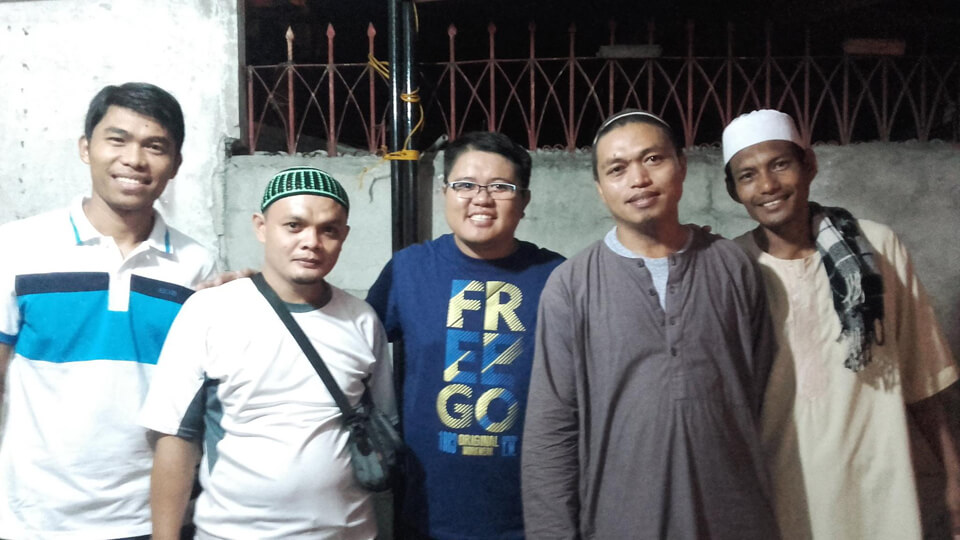
Jerry (far left), Elbert (center) and Muslim neighbors
From the Editor
The video above is a news report broadcast on CBS TV in the USA in June 1979 about a refugee camp on the tiny Malaysian island of Pulau Bidong, which was a refuge for countless Vietnamese ‘Boat People’ fleeing from the aftermath of the Vietnam War between the late 1970s and the early 1990s. In A Seminarian for Thirty Years Fr Dominic Derramas of the Diocese of Bacolod tells the remarkable story of a man who lived in Pulau Bidong from 1989 to 1991 as a refugee from Vietnam and who later became a priest in Canada, Fr Peter Tran.
We link Father Peter’s story with those of two other ‘Boat People’ who became Columban priests, Fr Peter Nguyen Van Hung who has been working with Vietnamese workers and trafficked persons in Taiwan, and Fr Nguyen Xuan Tien who works in Japan.
The three Vietnamese priests have something in common with a great missionary saint whose feast is celebrated on 17 March, St Patrick. He too was a ‘boat person’ in the sense that as a teenager he was kidnapped and taken by boat to Ireland to work as a slave. We tell his story in this issue, Saint Patrick (385 -461): The Impact of One Life, by Hallie Riedel.
We feature a quotation from St Patrick on our cover photo, ‘The Lord opened the understanding of my unbelieving heart, so that I should recall my sins and turn with all my heart to the Lord my God.’ During the six years that he spent taking care of sheep on a mountainside in Ireland the young Patrick re-discovered the faith he had neglected as a teenager.

Victoricus calling St Patrick to return to Ireland [Wikipedia]
When got back in Britain after escaping from Ireland St Patrick had a dream of a man named Victoricus bringing him countless letters from Ireland, ‘Vox Hiberniae – The Voice of Ireland’, asking him to return, which he did as a missionary bishop, one of the most remarkable missionaries in the history of the Church. During his six years as a slave in Ireland he came to know the Irish language and to understand the culture of the people there. He used all of this knowledge when he went back as a missionary. During his lifetime the Catholic faith took deep root there and in the centuries after his death many Irish monks went as Peregrini pro Christo, Pilgrims for Christ, to Britain and to mainland Europe. Perhaps the greatest of those was St Columban, the patron saint of the Missionary Society of St Columban.
St Patrick’s words, from the second paragraph of his Confessio, ‘The Lord opened the understanding of my unbelieving heart, so that I should recall my sins and turn with all my heart to the Lord my God’, give us the purpose of Lent, which has just begun. Lent is a gift of God to each of us and to all of us as Church. During the forty days of Lent we recall the forty-year journey of the Hebrews, refugees from Egypt, to the Promised Land.
During Lent and Easter on Sundays and solemnities we pray the Apostles’ Creed that ends with the words, ‘I believe in . . . the resurrection of the body and life everlasting. Amen.’ St Columban expressed this in a different way in his Eight Sermon: ‘Since we are travelers and pilgrims in the world, let us ever ponder on the end of the road, that is of our life, for the end of our roadway is our home.’

Irish Naval Service rescuing ‘boat people’ in the Mediterranean, 15 June 2015 [Wikipedia]
Maybe some ancestors of the fewer than 1,100 personnel of the Irish Naval Service were among the pirates who kidnapped St Patrick long ago. But between May 2015 and December 2016 Irish naval ships, cooperating with the Italian authorities, rescued more than 15,000 ‘boat people’ in the Mediterranean.
Our Hideaway
IF GOD WERE HUMAN
Reflections of a Beauty Queen
By Kristine Alonso
Kristine is affiliated with Carousel Productions Inc and is currently working at a call center in Bacolod City.

Kristine
‘And so it begins’, I said, as I ‘flipped through the pages of my life’.
Nine years ago a new chapter began in an unexpected turn of pitfalls and ruin. I had to permanently move residence and stop school for financial reasons and had not yet recovered from the recent deaths of my grandparents. But in the midst of all this God spoke a little madness, and that was where my journey began.
In the past I never valued dominance through attention, power or glory. And not even in my wildest dreams did I think of becoming somebody I never expected to be – for I was extremely shy and timid.
I felt at home with my musical musings and instruments; dreams of simplicity surrounded my yearnings. For I was never hungry for something egoistic nor imagining what it would be like to be something other than ordinary.
But before I knew it, I was in newspapers, on television shows and massive stages where a different personality was seeping in. God was in this evolution of my being, amidst the criticisms, the lies, the jealousies, the injustices and the victory that accompanied it, leading me towards something extraordinary.
I had never cared for the limelight before, regardless of my participation in theatrical plays and choirs in high school. I always knew I was ‘an old soul’ and never hungered for something temporary such as fame.

At the start of 2007 I started to become a beauty titlist and discovered the faces of human struggles, affliction, and victory. Setting goals was easy because you had special support to back you up, but the challenge was to keep centered on your faith.
I became lost, confused and somewhat arrogant to the point that I devalued myself. For I did not understand yet what value was. Beauty for me was but a silhouette of something that controls you, not knowing that God’s message for me at that time was to integrate what is beautiful to the eyes with what is beautiful for the soul. My journey was not easy and never perfect, but looking back helped me realize why things happened as they did.
I became sensitive to the ways of the world surrounding me, where some saw beauty queens as mere objects to be used for entertainment and others saw contests as occasions to feed a hunger for recognition and prestige. But that is not the point.
For society beauty is not only what you can see but a particular ideal of ‘perfection’. But that also is not the point. Trying to live up to this has influenced my journey and I think that God was speaking to me through this. He seemed to be saying to me, and through me to others, that what is ‘ideal’ is not necessarily what we need.
God is for me the only true perfection and we are like pieces of dust struggling to become sand or being formed into stone to become His solid vessels. And being part of an industry which focuses on what is materially and physically pleasurable can lead to many temptations and ill intentions masked as opportunities.
I began to get rebellious when some people started to treat me as if they owned me or thought that they could spit at me, as it were, whenever they liked. And I began to feel overpowered by an inner chaos.
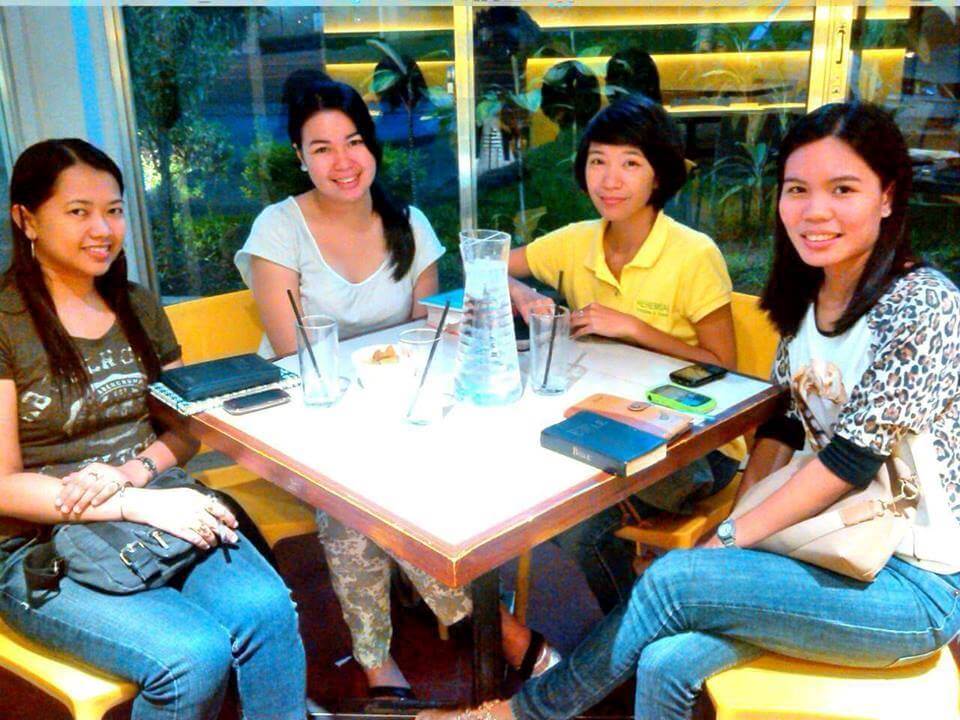
Kristine (2nd from left) with good friends
But God, who responded with guidance and love through my family and friends who stood by me, made me see that life does not end in harsh judgements or insults and that character only grows under conflict and is never killed. Being kind to others made me see that the ‘stones being thrown at me’ were needed on my journey.
Another setback was when I encountered some who stereotyped beauty queens and titlists as being engaged in prostitution. Some thought I was in this for money and fame and perhaps some even thought I was engaged in immoral behavior. But, with God’s grace, I was protected and accompanied by my family and some real friends who watched over me.
All of this demands hardwork, determination, passion and a purpose. God gave me the courage to ignore the shallow judgements of some and to fight the injustices surrounding me. God was in my words, my actions, within every move I made as I presented myself to people. I wanted to make sure that as a medium, the message should not just touch on what is temporary.
Not all women who walk on-stage can be bought wih money. Empowered women who know their direction and worth, like me, are never intimidated by power. Like other strong women, I know that victory is succeeding in one's ability to be comfortable being real and unique.
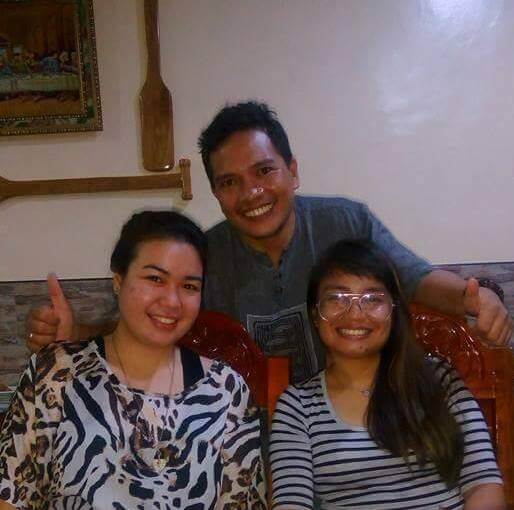
Kristine with Fr Christian Benjamin and Aina Siason, advocate for persons with disabilities and interpreter for the Deaf
Where is God in all this? God is in wisdom, in strength, in the actions of all who reject immoral deeds for advantage. Those persons will know that it is only through God’s power that they will advance towards their goal.
I burn with the faith that God has amazing plans for me beyond my own. I must tell everyone that the blinding sparkles of vanity and materialism in the pageantry can also be a medium to heal the insecure, the unwanted, the frustrated, that amidst the disadvantage comes the advantage of becoming an instrument to positively influence a wounded soul, a broken heart or a lost spirit.
‘And so it begins’, I said to myself nine years ago. Nine years later I see that my struggle with temptations and my ego was the best kind of struggle. I needed to throw so much away and become the real me that God wanted me to be. As St Thérèse of Lisieux wrote, ‘Perfection consists simply in doing his will, and being just what he wants us to be’.
Beauty is not just in the face. You need to pair it with guts and faith in God. Then anything is possible. Most people think you become a stranger to yourself in pageantry, but if we dig deeper, we control ourselves with patience, determination, and direction.

Kristine (far left) with good advice for our health and the health of the earth!
The pageantry in all of this has been an outlet for me and others in improving self-confidence, finding self-worth, a place where one begins to create one’s own standards in a situation where others have been doing that for you.
If God were human – and indeed God the Son being a human being in Jesus Christ – I think he would see the spotlight as one means of testing the kind of person that you are. And I have learned that the world is fleeting and that triumphs and failures become part of our story, a story that we will share with others, a story that shows that all wounds can be healed and that one can continue to grow as a person.
Peace By Peace
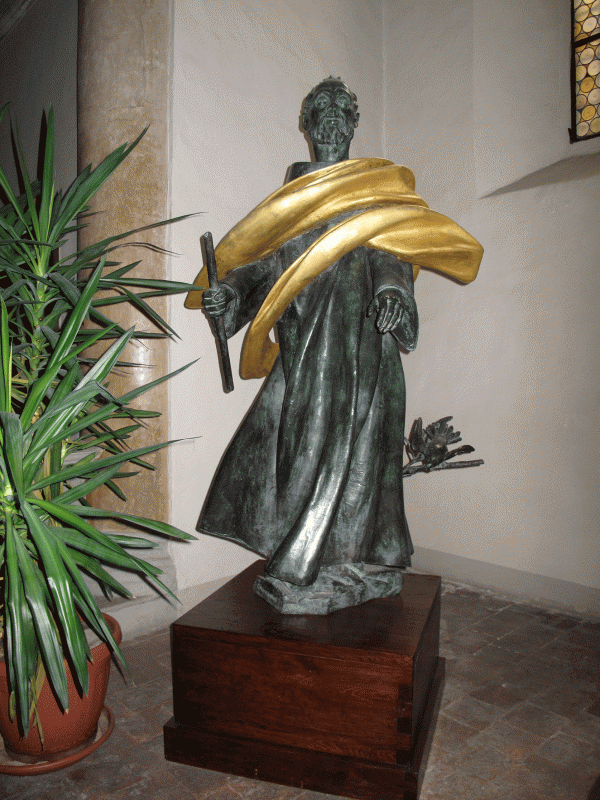
Statue of St Columban, Bobbio, Italy
Understand the creation, if you wish to know the Creator; if you will not know the former either, be silent concerning the Creator, and believe in the Creator.
– St Columban, Sermon 1:5 Sermons of Columbanus (559–615)

If we have no peace, it is because we have forgotten that we belong to each other.
– St Mother Teresa (1910–1997)

Let's try not to be exacting with other people, but rather to pass over in silence those thousand little annoyances that tend to irritate us. For we know that no one is perfect in this life, and we must put up with the defects of others as they put up with ours.
– St Rose Philippine Duchesne, virgin, religious sister and educator (1769–1852)

Blaise Pascal, painting by François II Quesnel [Wikipedia]
All of humanity's problems stem from man's inability to sit quietly in a room alone.
– Blaise Pascal, mathematician, physicist, inventor, writer and Christian philosopher (1623–1662) From his Pensées (‘Thoughts’)

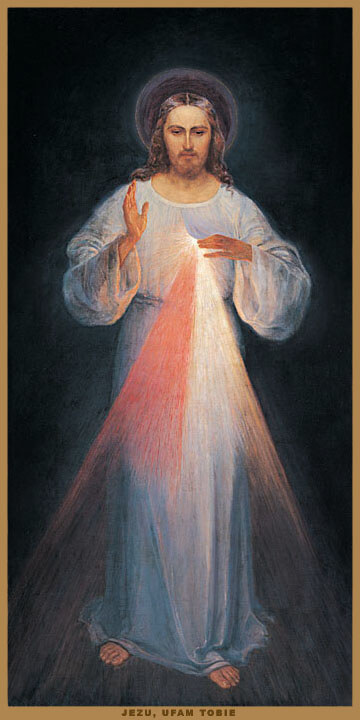
The original Image of the Divine Mercy by Eugeniusz Marcin Kazimirowski, painted under the guidance of Saint Faustina [Wikipedia]
A talkative soul lacks both the essential virtues and intimacy with God. A deeper interior life, one of gentle peace and of that silence where the Lord dwells, is quite out of the question. A soul that has never tasted the sweetness of inner silence is a restless spirit which disturbs the silence of others.
– St Mary Faustina Kowalska, nun and mystic (1905–1938)

The Deer's Cry (The Breastplate of St Patrick)
I arise today
Strengthened by Christ’s own baptism
made strong by his crucifixion and his burial
made strong by his resurrection and his ascension
made strong by his descent to meet me on the day of doom.
St Patrick’s Day is celebrated on 17 March.
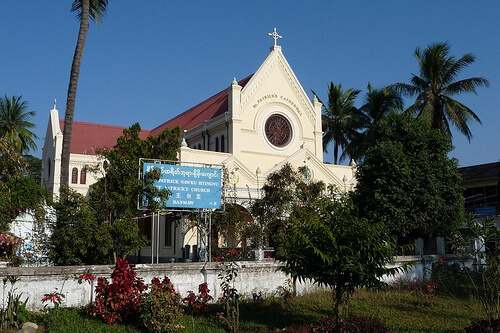
St Patrick’s Cathedral, Banmaw (Bhamo), Myanmar [Source]
The Columbans have been involved in the Church in the Kachin State in northern Myanmar (Burma), in what are now the Dioceses of Banmaw and Myitkyina, since 1936.

Saint Patrick (385-461): The Impact Of One Life
By Hallie Riedel
St Patrick is the patron saint of Ireland and of Nigeria. His Feast Day is 17 March, Ireland’s National Holiday.We thank The Word of Life, www.wau.org , for this article. Hallie Riedel is a Contributing Writer for that magazine, published in the USA but also available in a Philippine edition. She is married and has three children.
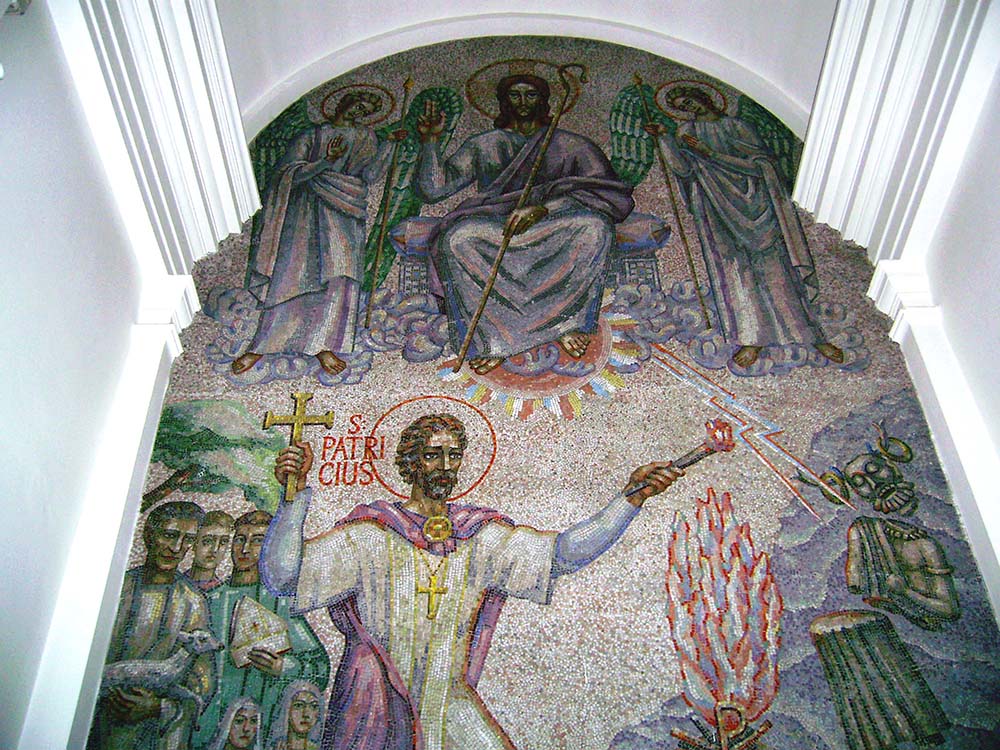
St Patrick lighting the Paschal Fire in Slane
Mosaic by Boris Anrep, Christ the King Cathedral, Mullingar, Ireland
What can an indolent, self-absorbed teenager have to do with God's plan for evangelizing a nation? Sixteen-years-old and from a well-to-do family, this kid has never applied himself to his studies, let alone taken his Christian faith seriously. And yet, through one of those dramatic reversals of fortune that God sometimes allows, the sluggish youth meets the Lord and goes on to become Ireland's great evangelizer, Saint Patrick.
Patrick himself tells the story in his moving Confession. Unlike the many legends that sprang up after his death, this authentic account of his conversion and development is a window into the life of a real person. In it, Patrick speaks honestly of his regrets, struggles, and successes, and always in a tone of heartfelt thanks that ‘the Lord had mercy on me thousands and thousands of times.’ In this fifth-century bishop, we touch the faith of someone who threw himself completely on God's love - someone who inspires our own faith that, if we accept it, divine love can transform and equip us for God's service, too.
Learning to Listen
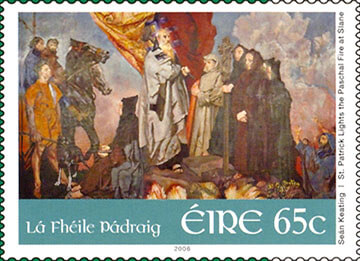
There is much that Patrick never thought to include in his Confession - so much that one biographer compared the saint's story to a jigsaw puzzle with all the important pieces missing! We do know that Patrick was born in Roman Britain to well-to-do parents who were Christian, but not especially religious. Turbulent upheavals took place during his lifetime (about 385 to 461), most notably the barbarian invasions and the collapse of the Roman Empire in the West.
Young Patrick's privileged lifestyle came to a sudden end around 401, when he was kidnapped by marauding raiders. They took him to Ireland, where he was enslaved for six years. Patrick came to view this apparent tragedy as the best thing that ever happened to him. Left alone to shepherd flocks, without shelter and without comfort, he turned to God and learned to pray: ‘I would pray all the time, right through the day. More and more, the love of God and fear of him grew strong within me, and as my faith grew, so the Spirit became more and more active. . . In snow, in frost, in rain, I would hardly notice any discomfort.’
As his prayer life deepened, Patrick learned to rely on God and listen for the voice of the Holy Spirit. Through dreams, God assured him that he would return home. He even directed him to the particular ship that would take him there. ‘Not that it was near at hand,’ Patrick wryly remarked. ‘Rather, it was two hundred miles away, in a place I had never seen before and where I knew not a single soul.’ Nevertheless, Patrick obeyed, made good his escape, and found the ship, just as the dream had foretold.
But the testing of Patrick's faith continued, as the captain refused to let him aboard. Patrick's response? ‘I decided to go back to the little hut where I had been staying, and on the way there, I began to pray.’ His confidence in God was rewarded almost immediately: ‘Before I could even get my prayers into focus I heard one of the sailors call after me, “Come, hurry!”’
At the captain's entreaty, Patrick also had occasion to exercise his faith in a more public way. Food ran out after the ship landed in some ‘deserted country,’ perhaps Gaul (modern France), where Germanic hordes had recently sacked and ravaged the land. ‘Turn trustingly to the Lord who is my God,’ was Patrick's advice. ‘Put your faith in him with all your heart, because nothing is impossible to him.’ Suddenly, dinner came walking down the path in the form of a herd of pigs.
The Joy of Obedience
Once back in Britain and reunited with his family, Patrick could easily have fallen back into his old, comfortable patterns. But he had changed for good.
More dreams came. In the first, an Irish messenger handed Patrick one of ‘countless letters’ he was carrying. Reading its opening words – ‘The Voice of the Irish’ - Patrick heard voices crying, ‘We beg you, come back and walk once more among us.’ The plea pierced his heart, inspiring both a love for the people who had been his captors and the conviction that God had work for him in Ireland.
It was not with grim resignation that Patrick decided to return to the land of his enslavement. On the contrary, God's call filled him with joy and astonishment that ‘after so many hardships and great burdens, after my captivity, after so many years spent living among this people that [God] should grant me so great a grace - something which, as a boy, I could never have hoped for or even dreamt possible.’
In 432, after ordination and years of preparation about which little is known, Patrick returned to Ireland. This time he came as a bishop, not a slave.
Through Many Dangers
St Patrick lighting the Paschal Fire, symbol of the Risen Christ
Patrick was not the first to carry the gospel to Ireland, but it was through his tireless efforts that Christianity really took hold there. During his thirty-year ministry, he made thousands of converts, established churches, founded monasteries, and developed native clergy. Humbly amazed at this success, he attributed everything to God's grace.
It is impossible to know which of the legends about Patrick are historically accurate. Very likely, his preaching brought him into confrontation with local kings and Druid priests. Sometimes, even Christians opposed him, as some of the British did when Patrick excommunicated Coroticus, a Welsh prince. In his Letter to the Soldiers of Coroticus, Patrick rails against this supposed Christian's enslavement or slaughter of a number of newly baptized Irish Christians, the chrism ‘still gleaming on their foreheads.’ Patrick urged the British bishops to join him in ostracizing Coroticus, so as to stir him to repentance and restitution. How they responded is unknown.
Patrick was acutely aware that he was accomplishing his mission at the risk of his life. Twelve unspecified ‘dangers,’ slavery, and ‘numerous plots’ were only a few of the perils from which God saved him. ‘Daily I expect murder, fraud, or captivity, or whatever it may be; but I fear none of these things because of the promises of heaven. I have cast myself into the hands of God Almighty.’
Only obedience to God's call had brought him back to Ireland, Patrick said. Secure in the knowledge that he was exactly where God wanted him, he could work without fear.
A Culture Transformed
The fruit of Patrick's obedience showed itself not only in the astounding growth of the Irish church itself, but also in its transformation of Irish culture through the influence of the gospel.
The practice of human sacrifice was abandoned. By the sixth century, slavery had become unacceptable. New Christian laws reduced warfare. Monasteries built extensive libraries where Irish scholarship flourished. Within a century after Patrick's death, the Irish devised the Celtic alphabet. They learned Latin, Greek, and some Hebrew. They translated or copied Irish folklore and Christian writings, and also the classics of Greek and Roman literature. Without this, many of these works would have been lost forever.
The gospel sanctified Ireland's existing native culture, rather than bringing about its eradication. In a way that had rarely happened elsewhere, God's word at work elevated the people and their way of life. One example is the Irish love of nature, which was lifted from its pagan, Druid setting to a higher plane. We see this in the prayer which is often called Saint Patrick's Breastplate. Here, the Christian creed expands and combines with themes such as God's presence in creation, the world as a signpost to God, and nature as good and divinely created:
I arise today
in a mighty strength,
calling upon the Trinity,
believing in the Three Persons
saying they are one
thanking my creator . . .I arise today
through the strength in the sky
light of sun
moon's reflection
dazzle of fire
speed of lightning
wild wind
deep sea
firm earth
hard rock . . .
God's Ripple Effects
When Patrick returned to Ireland, he had no idea how profoundly his proclamation of the gospel would affect the entire culture. He was simply trying to obey God's voice and be faithful to his calling. But as Pope John Paul II said in a 1979 address at Saint Patrick's College in Maynooth, Ireland, there's no telling what God will do with a person's faithful obedience:
I wish to recall to you one simple but important lesson taken from the life of Saint Patrick, and it is this: In the history of evangelization, the destiny of an entire people - your people - was radically affected for time and eternity because of the fidelity with which Saint Patrick embraced and proclaimed the word of God, and by reason of the fidelity with which Saint Patrick pursued his call to the end.
What I really want you to realize is this: that God counts on you: that he makes his plans, in a way, depending on your free collaboration, on the oblation of your lives, and on the generosity with which you follow the inspiration of the Holy Spirit in the depths of your hearts. The Catholic faith of Ireland today was linked, in God's plan, to the fidelity of Patrick. And tomorrow, yes, tomorrow some part of God's plan will be linked to your fidelity - to the fervor with which you say yes to God's word in your lives.
It's impossible to know the impact God intends each of us to have! Every act of obedience to the Spirit's voice, every moment spent in prayer took Patrick further down the road of God's plan. He couldn't see the end result. Neither can we.
Through Patrick, the complacent teen turned fearless apostle, God transformed a people and culture in a way that has had an impact far beyond Ireland's shores. How he will use our own faithfulness and trust is up to him. Like Patrick, we have only to follow the Lord step by step, with confidence in his love and presence. And with thankfulness, too, that in the divine plan, every decision for good can have a ripple effect that changes the world.
Saint Patrick's Breastplate
Christ be with me
Christ before me
Christ after me
Christ in me
Christ under me
Christ over me
Christ at my right hand
Christ at my left hand
Christ in the wide expanse
Christ in the far distance
Christ in the heights
Christ in the heart of every
person who thinks of me
Christ in the mouth of
everyone who speaks to me
Christ be in every eye that looks upon me
Christ in every ear that hears me.
Tales of Columban Courage and Martyrs
On St Columban’s Day, 23 November 2017, we will begin the Centennial Year of the Missionary Society of St Columban that was formally established in Ireland on 29 June 1918, the Feast of Sts Peter and Paul. The Centennial Year will end on St Columban’s Day 2018. Below we have two stories of Columban martyrs, one in China and three in Korea. These first appeared in Far East, the magazine of the Columbans in Ireland and Britain. And are slightly edited here. We will continue these Tales of Columban Courage and Martyrs in subsequent issues..
Fr Timothy Leonard, the First Columban Martyr
‘He did not work for Christ: he slaved for him’
By Fr Cyril Lovett
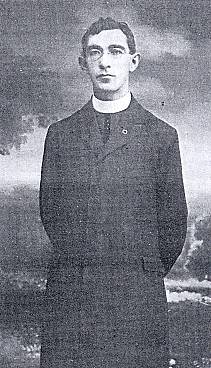
Fr Timothy Leonard (1893 – 1929) [Source]
Fr Cyril Lovett, from Ireland, is one of three brothers who became Columban priests. He worked for many years in the Philippines and then in Brazil and was, until recently, editor of Far East. Fr Brendan teaches at the Institute of Formation and Religious Studies (IFRS), Quezon City. Fr Aidan served in Mindanao, Malate Parish and Manila doctors Hospital. He died in 1999.
On Tuesday 24 July 1929, a telegram brought sad and unexpected news from China. Fr Timothy Leonard had been murdered by bandits in the Province of Kiangsi on 17 July 1929. He became the first of many Columbans to suffer a violent death while serving their people on mission.
Fr Tim Leonard, from Ballysimon County Limerick, Ireland, had studied in St Patrick’s College, Maynooth, the national seminary in Ireland, and was ordained a priest for the Diocese of Limerick in 1918. Immediately after ordination he joined the Columbans and became one of the first group of sixteen to go with Fr, later Bishop, Edward Galvin, co-founder with Fr John Blowick, to China in 1920. They went to work in the Han Yang Vicariate in the Province of Hupeh (Central China). An article from the time of his death reads, ‘From the very first Fr Leonard seemed determined to spend himself in winning souls for his Divine Master. His zeal was tireless. He did not work for Christ: he slaved for him. Many a time his comrades warned that even his iron constitution could not stand the strain he was putting on it. But he never seemed to mind, or to think he needed either rest or attention’.
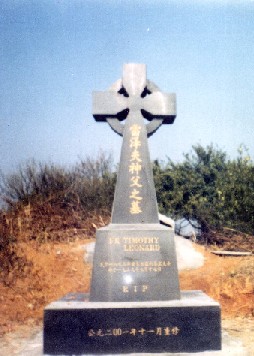
Celtic Cross marking Fr Leonard’s grave in China [Source]
In 1928, the Holy See assigned the Columbans a new district in the Province of Kiangsi. Father Tim was one of a select band of seasoned missionaries who were transferred from the Han Yang Vicariate. Again he threw himself heart and soul into the work. Attacks by small groups of Communists or local bandits were common at the time. It appears that gunfire was heard in the street at about 3am. Father Tim believed that the soldiers inside the walled city were firing on the Communists or bandits outside. Still, he decided to celebrate Mass earlier than usual, at 5.30am. He had just reached the altar when the compound was surrounded and the church broken into by a ragged mob. The bandits seized Father Tim and his altar server and bound them. The young priest pleaded that he needed some necessary articles from the tabernacle. As soon as he opened the door, the bandits snatched the ciborium scattering the Sacred Hosts. Father Tim was led outside the church where a ransom of $30,000 was demanded. He stated that he had little money but offered to hand over what he had if the boy were set free. The boy was set free, and they took Father Tim away with them.
On the evening of 15 July the local Christians lost touch with him. The following morning the bandits, evidently hoping to get a ransom for him, allowed them to visit him at a place in the mountains about 32 kms away. This was the last occasion the Christians saw him alive. He was badly wounded and suffering intensely. His only question was about the Christians in Nan Feng. On being assured that they had not suffered, he said, ‘Thank God, my mind is now easy. As for myself it cannot be more than a matter of a few days’. By 17 July, his fellow Columbans received word that Father Tim was already dead. His body was discovered on 18 July: he was covered with wounds and his head partly severed from his body. He was buried on 20 July in the presence of his colleagues Frs Patrick Dermody, Patrick Quigley, both Columbans, and Fr Chow, a local priest. His grave, now marked with a Celtic cross, has become a shrine where local Christians still visit to pray.
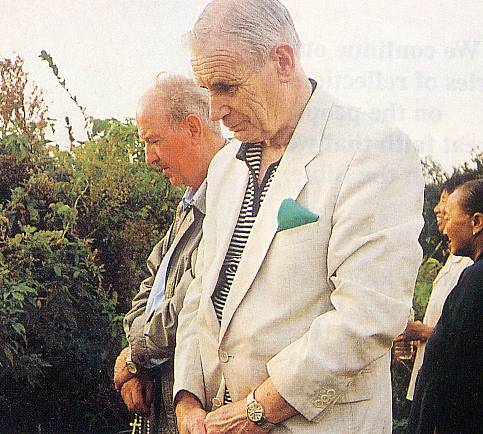
John Leonard, with Columban Fr Joseph Heuston, at Fr Leonard’s grave 2002 [Source]
In the November-December 2013 issue we published an article by Fr Patrick Baker: Memorial Mass for Fr Timothy Leonard. A relative of Father Time, John Leonard from Ireland was present at the Mass in the Columban House of Studies, Cubao, QC.
Thanks to the Diocese of Limerick, Ireland for permission to use the photos above.

Columban Martyrs in Korea
‘A pastor cannot desert his flock’
By Fr Donal O’Keeffe
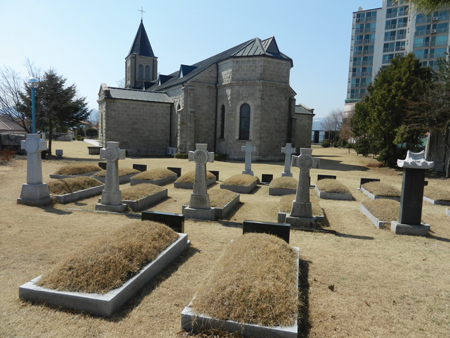
Columban graves, Sacred Heart Cathedral, Chuncheon
Since 1976 Columban Fr Donal O'Keeffe, from Ireland, has worked in Korea with factory workers, urban poor and more recently in mission promotion/education. He has also served as Regional Director in Korea. Here he writes about three of the seven Columban priests who were killed during the Korean War, Fr Anthony Collier, Fr James Maginn, Fr Patrick Reilly, Fr Thomas Cusack, Fr John O’Brien, Fr Francis Canavan and Msgr Patrick Brennan. The cause for their beatification as martyrs of the 2th century, among a list of 84, was initiated by the Church in Korea in 2014.
At the end of World War Two Korea was divided by the great powers at the 38th Parallel. Tensions between the two parts erupted into armed clashes which eventually ended with the invasion of the South by the North on Sunday morning 25 June 1950.
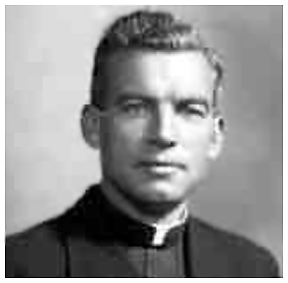
Fr Anthony Collier
Fr Anthony (Tony) Collier was born at Clogherhead, Co Louth in 1913. He entered the Columban seminary in Ireland in 1932, was ordained there in December 1938 and assigned to Korea in 1939. His brother, Father Kieran, worked as a Columban in Burma and his nephew Father Ray, also a Columban, today works in Birmingham, England. He spent the early years of his priesthood in Mindanao.
Father Tony had barely finished language studies in Korea when along with other Columbans he was placed under house arrest when Japan joined the war in 1941. Released in 1945, he was appointed in 1949 as the first parish priest of the new parish of Soyangno, Chuncheon city.
After Sunday Mass on 25 June 1950 the escalation of violence was the main topic of conversation. People talked of fleeing and wanted the priests to come with them. In Chuncheon that afternoon, Fr Tony Collier met Frs Tom Quinlan and Frank Canavan to discuss the situation. An American officer offered to take the priests to safety but they declined. Fr (later Archbishop) Tom Quinlan later wrote that Father Tony refused saying, ‘I want to be with my parishioners’.
Two days later, Father Tony and the parish worker Gabriel Kim were arrested by North Korean soldiers. Accused of being spies, they were tied together and shot. Father Tony was killed instantly and Gabriel was wounded but when falling to the ground Father Tony fell over on Gabriel. The soldiers left them believing both had died. Gabriel eventually escaped and gave an account of Father Tony's death to the Columbans. Fr Collier was the first foreigner to die in the Korean Conflict. He was 37.
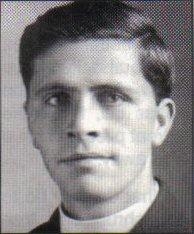
Fr James Maginn
Meanwhile, 135 kms to the east in the coastal city of Samcheok, the second Columban to die, Fr James (Jim) Maginn had celebrated Mass that Sunday. Born in 1911 in Butte, Montana, USA, his family returned to County Down, Northern Ireland. He entered the Columban seminary in Ireland in 1929 and was ordained there in December 1935. He was assigned to Korea in 1936. Like Father Tony, he was placed under house arrest when Japan joined World War Two. Released in 1945, he was appointed pastor to a new parish in Samcheok city in 1949.
The parishioners pleaded with Father Jim to flee but, as many of them testified later, he declined saying, ‘As pastor I am staying here in the church’. He divided up the money in the safe giving it to the people. He was arrested some time later and eventually shot on 4 July 1950. He was 39.
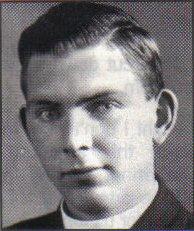
Fr Patrick Reilly
Just 10 kms to the north of Samcheok, in the parish of Mukho, it was a similar story for Fr Patrick (Paddy) Reilly. Born in County Westmeath, Ireland, in 1915, he was ordained in December 1940 and assigned to Korea. However, due to World War Two he was unable to travel until 1947. He had worked in Clifton Diocese, England, from 1941 till 1947. After language studies he was assigned as the first pastor of the new parish of Mukho to the north of Samcheok. After Sunday Mass the people tried to persuade him to leave but as they later attested he told them, ‘A pastor cannot desert the flock’. He did move from the convento to stay in the home of the catechist where he celebrated Mass frequently for the remaining believers. However, he was arrested on 29 August 1950. Later, his body was found on a mountain path - he had been shot through the chest. He was 35.
All three were buried close to where they died. Their bodies were later reinterred behind the Cathedral in Chuncheon. All three made conscious decisions to stay with their people even though they had ample opportunities to flee. For that reason the Korean Church views them as martyrs and is promoting their beatification.
Fr James Maginn’s first cousin Teresa shares her memories of the Columban priest
To Search Is To Find
Because of the alarming rate of suicide among our generation, we've been discussing in class how beautiful life is and what we can do if we encounter a friend having suicidal tendencies, and how to cope if we also feel depressed. I’m wondering too if any priests or religious experience suicidal tendencies or depression. If so, what provokes this?

Café Terrace on the Place du Forum, Arles, at Night, Van Gogh [ Web Gallery of Art ]
‘Yes! What a grace it is to have faith! If I had not any faith, I would have committed suicide without an instant’s hesitation.’ These were the words of a nun a week before she died aged 24, in 1897, from a very painful form of tuberculosis – St Thérèse of Lisieux.
Yes, some priests and religious experience depression or may have suicidal thoughts. By ‘depression’ I mean clinical depression, which is very different from an occasional experience of feeling down and annoyed with everyone. That is often due to something as simple as tiredness, which in turn may be caused by the way we mismanage our time and energy.
I have never experienced depression or suicidal thoughts but I have known people close to me who have. One was a Filipino religious sister who took her own life nearly thirty years ago. Those close to her were aware that she was going through a very difficult time and offered her lifelines but she didn’t grasp them.
In recent years in Ireland there have been four or five suicides by diocesan priests. In at least some cases there were no indicators to those around them that they were having suicidal thoughts.
But the question is really about suicide among young people and what to do. When I was a young priest studying in the USA a wise religious sister advised me that if I ever heard a person talking about the possibility of suicide I should take that person seriously. Her advice has helped me ever since. I know for sure that, with God’s grace, I enabled one young person – I’ll call her ‘Rose’ – in her 20s, whom I had known for a long time, to choose life after she had begun the process of a slow suicide by taking an overdose of a strong medicine prescribed for a serious illness she had. This was in the USA when I was on a visit there.
I have learned from experience that some persons of strong and active faith can be very ‘fragile’ emotionally. ‘Rose’ was such. What triggered off her suicide attempt was an expectation that she thought her mother was laying upon her even though she was living on her own at the time. When she asked me what expectations I had of her I said, ‘I don’t have any, only hopes.’ This was the turning point for her and she chose to live.
From experience I know that one very important element is being able to listen to another and to really hear what that person is saying, to show understanding and genuine care. Not everyone has the ability to listen in that way but we can show care and encourage a person close to us meet a professional psychiatrist, psychologist, counsellor, priest or someone that he or she knows to be mature, responsible, trustworthy and a good listener.
The Church has always taught that suicide is objectively a grave sin. (You will find the Church’s teaching in the Catechism of the Catholic Church, Nos 2280 – 2283). But in all the cases I am personally familiar with, the persons involved had been under great inner stress, sometimes unknown to those around them. At times the signs were clear, professional help was sought by the family/community and given but the person under stress still took the ultimate step. I truly believe that in many cases the person had no real inner freedom. I am certain that God has great mercy on them, as the Catechism No 2283 indicates.
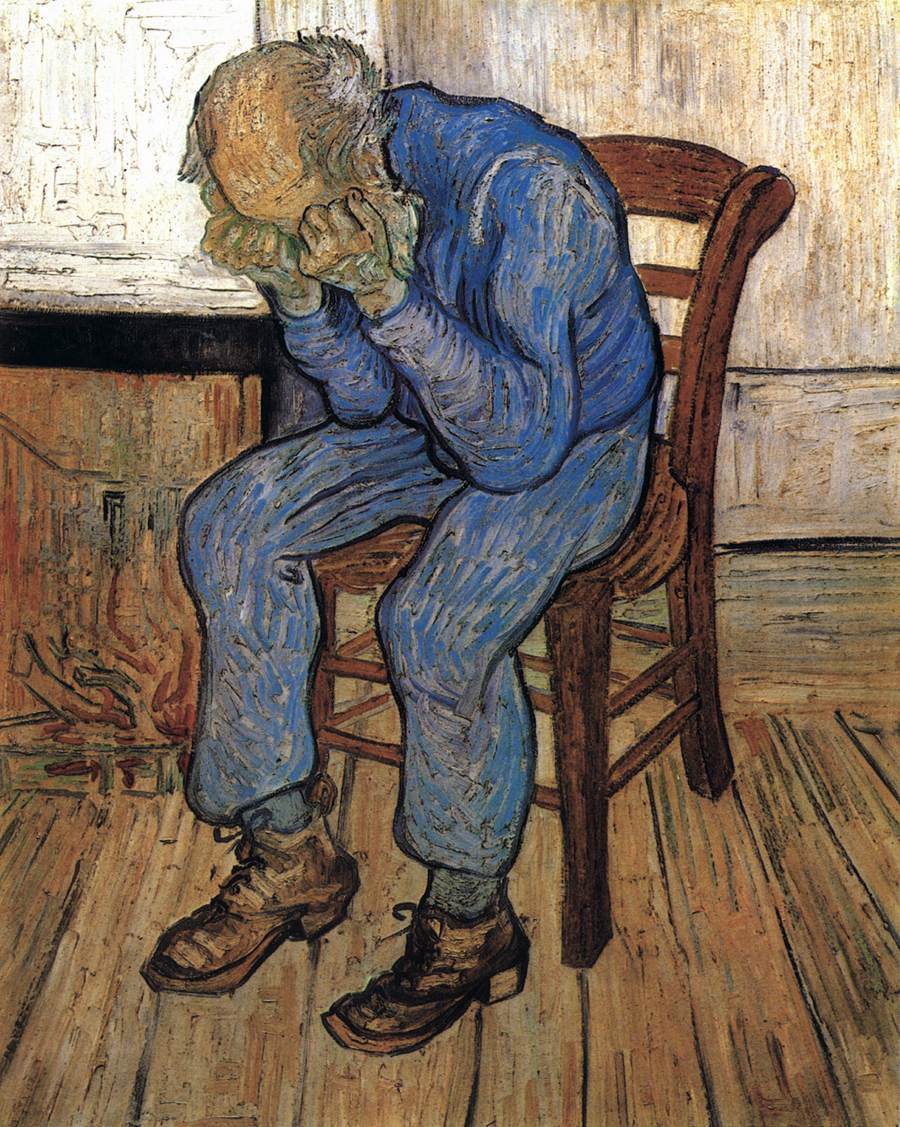
Old Man in Sorrow, Van Gogh [ Web Gallery of Art ]
But suicide always devastates the family or community of a person. And we should never glorify suicide in any way, particularly when we are grieving for someone who has taken that ultimate step. We should rather entrust that person to God’s mercy.
Clinical depression does not always lead to suicidal thoughts and I have friends who have experienced it, a number of times in some cases, but have come through it. A painful incident may trigger off suicidal thoughts, as in the case of ‘Rose’, but it is like pain revealing an illness that has been growing silently and needs to be treated.
One of my favorite lines in the Bible is from Psalm 149: 4, ‘For the Lord takes delight in his people.’ Another is: ‘In this is love: not that we have loved God, but that he loved us and sent his Son as expiation for our sins’ (1 John 4:10). I see these two verses as beautiful expressions of God’s unconditional love for us. We cannot earn God’s love and should never try to do so. It is a gift.
We need to be aware of our own dignity, of being made in the image of God, and, if baptized, of being a son or daughter of God. As the priest pours a little water into the wine at the offertory of the Mass he says, ‘By the mystery of this water and wine may we come to share in the divinity of Christ who humbled himself to share in our humanity.’ Every human being is called ‘to share in the divinity of Christ’.
In the video below Jean Vanier, a former naval officer and professor of philosophy, who has shared most of his life with persons with mental/learning disabilities speaks of seeing God in others. What he says applies to each of us, especially when he speaks of ‘the primal cry: do love me . . . Why have I been abandoned? Does my life have any value?’ There is something of this in each of us but especially in those in deep emotional/mental distress. If we see signs of the latter in anyone we know we should try to gently invite that person to open up so that we can bring some hope into that person’s life.
Fr Ronald Rolheiser OMI, a Canadian Oblate priest, has written frequently about suicide and I have found his writings helpful. One example is here. If you google ‘Fr Ronald Rolheiser OMI, suicide’ you will find links to other articles on this topic.
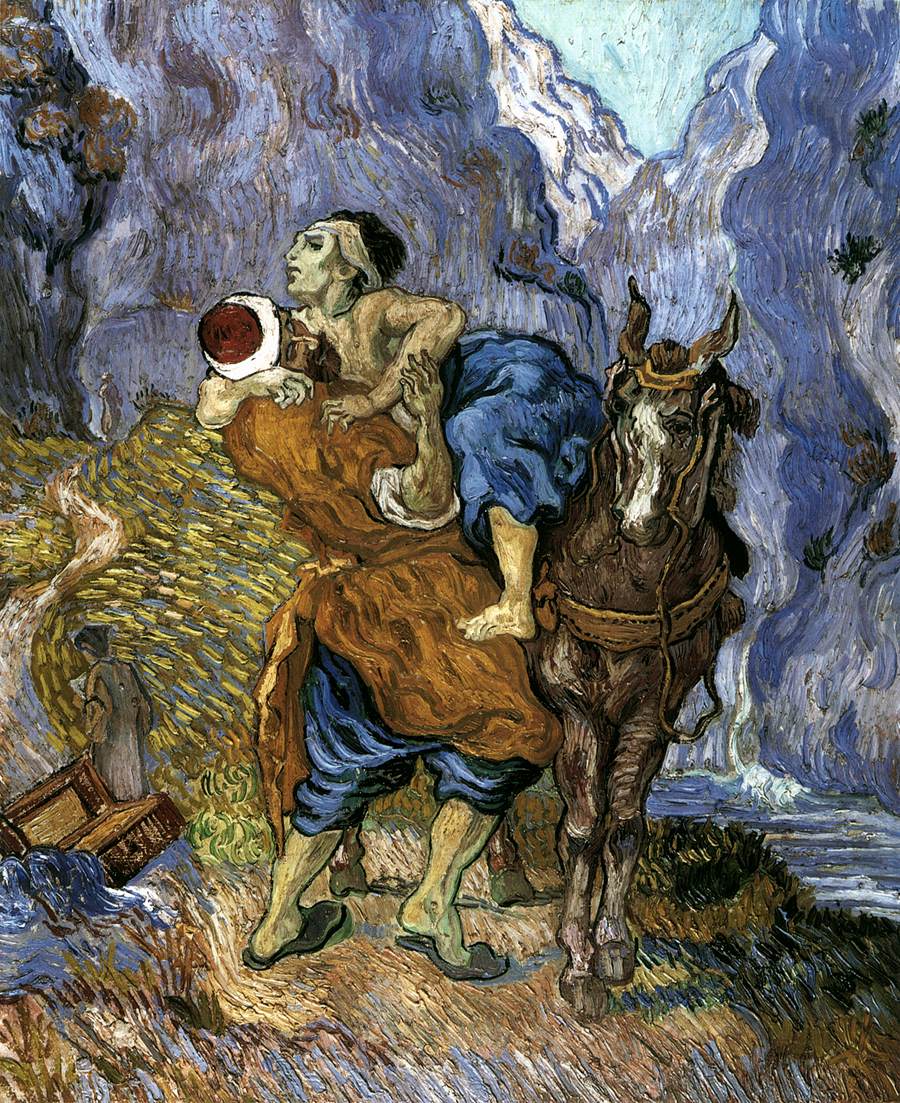
The Good Samaritan (after Delacroix), Van Gogh [ Web Gallery of Art ]
